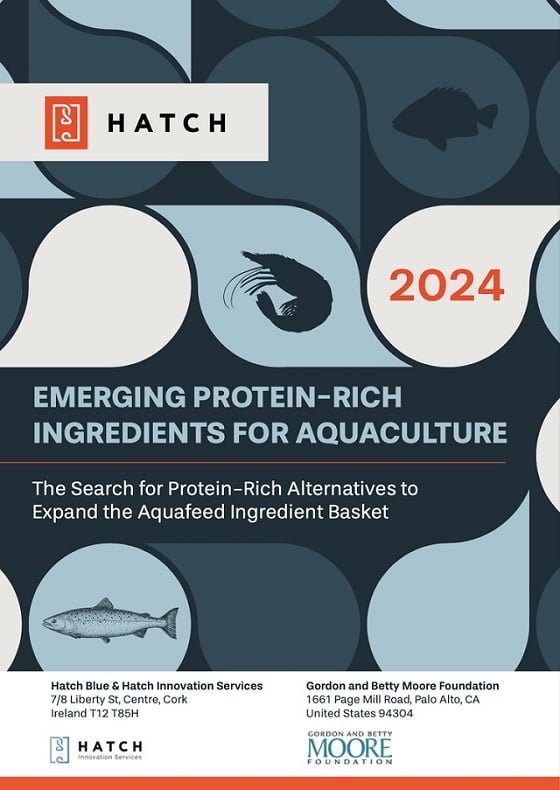
The global appetite for seafood products is growing, and aquaculture plays a crucial role in meeting this demand. However, sustaining a thriving industry requires a continuous and secure supply of protein-rich inputs.
The report prepared by HATCH, sponsored by the Gordon and Betty Moore Foundation, delves into the exciting world of emerging protein sources and explores their potential to revolutionize how we feed farmed fish.
The document aims to identify the most competitive emerging protein-rich ingredients to complement existing commercialized ingredients, expand the raw material basket, and close the protein gap in feeds.
Beyond the basics: ingredients with potential
While meeting the nutritional needs of fish or shrimp is crucial, it is only the first step. This report identifies promising contenders that must also be:
- Produced in large quantities: Sufficient to meet industry demands.
- Cost-competitive: Affordable compared to existing options.
- Rigorously tested: Demonstrated to be safe and effective through long-term trials.
Currently, most emerging ingredients face challenges in volume and cost. However, some, like fermented corn protein, show promise despite lower initial adoption. With ongoing research and investment, a few are nearing commercial viability in terms of nutrition, price, volume, and consistency.
Innovation at the core: Where do these ingredients come from?
Identified ingredients are divided into three key categories of innovation:
- Recycling power: Transforming low-value materials (corn by-products, soy waste) into high-quality ingredients. This includes fermented corn protein, fermented soy flour, barley protein concentrate, and others.
- Reutilization for the future: Adapting existing industrial processes, such as those used for methanotrophic bacteria and mycelium production, for creating new ingredients.
- Engineering for efficiency: Developing crops with higher protein yields through genetic improvements (future potential).
Beyond fishmeal: a basket of ingredients
Traditionally, fishmeal is the gold standard for aquaculture feed protein. However, concerns about costs, sustainability, and supply variability have driven the search for alternatives. Soy flour emerged as a significant player, but limitations in digestibility and environmental considerations have spurred further exploration.
This report identifies a new wave of promising ingredients poised to join the input group for aquaculture feed formulation:
- Fermented corn protein: A high-volume option derived from ethanol production, offering a short-term solution.
- Fermented soy flour: An innovative twist on a familiar ingredient, improving digestibility and potentially mitigating concerns about GMOs.
- Barley protein concentrate: With exceptional digestibility in salmon, this option is rapidly increasing production.
- Insect meal: These bioconverters utilize organic waste streams, offering a sustainable protein source with high potential.
- Methanotrophic bacteria: Harnessing natural gas to create an endless protein source, this option requires further development but is immensely promising.
- Mixed nut meal: This option offers superior nutrition and digestibility, particularly for trout, with potential for broader production beyond California.
While these ingredients show exciting potential, several hurdles remain before widespread adoption:
- Increased production: Production processes need refinement to ensure consistent quality and quantity at commercially viable levels.
- Investment considerations: Securing capital to finance essential infrastructure is crucial for emerging ingredient producers.
- Testing marathon: Feed producers demand rigorous testing and long trial periods before including new ingredients in aquaculture feed formulations.
Learning from neighbors: Synergies beyond aquaculture
The emerging protein ingredient market extends beyond aquaculture feeds. Pet food and neonatal livestock markets also offer valuable outlets, providing revenue streams during crucial early development stages.
Sustainability at the forefront
As the ingredient basket expands, understanding the environmental impact of each source is critical.
Life cycle assessments (LCA) play a fundamental role in assessing the environmental impact of these new ingredients. This report highlights plant-based options and those using agricultural by-products for having a lower environmental footprint.
Conclusion
The successful integration of these emerging ingredients requires collaboration across the aquaculture value chain. Ingredient producers, investors, and research institutions working together can unlock the full potential of these innovations, paving the way for a more sustainable and secure future for aquaculture.
Reference (open access)
Chen Linda. 2024. Emerging Protein-Rich Ingredients For Aquaculture – Report 2024. HATCH – Gordon and Betty Moore Foundation. 92 p.
Editor at the digital magazine AquaHoy. He holds a degree in Aquaculture Biology from the National University of Santa (UNS) and a Master’s degree in Science and Innovation Management from the Polytechnic University of Valencia, with postgraduate diplomas in Business Innovation and Innovation Management. He possesses extensive experience in the aquaculture and fisheries sector, having led the Fisheries Innovation Unit of the National Program for Innovation in Fisheries and Aquaculture (PNIPA). He has served as a senior consultant in technology watch, an innovation project formulator and advisor, and a lecturer at UNS. He is a member of the Peruvian College of Biologists and was recognized by the World Aquaculture Society (WAS) in 2016 for his contribution to aquaculture.
